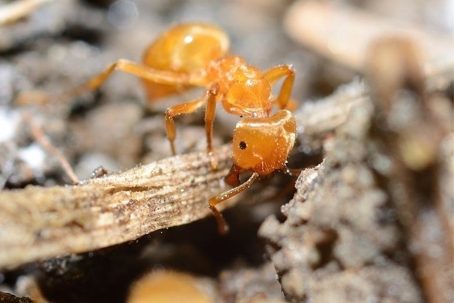Do Citronella Ants Bite?
Citronella ants (Lasius interjectus) are called “citronella ants” because of the lemony scent they emit when crushed, are generally not aggressive toward humans or pets. These ants rarely bite, and when they do, it’s usually in very specific circumstances:
Disturbance of their nest – Citronella ants live in soil, under rocks, or in decaying wood. If someone accidentally steps on or digs into their nest, the ants may bite defensively to protect the colony.
Direct handling – Picking up or touching individual ants can provoke a defensive response. Since they are small, the bites are minor and not typically painful.
Food competition – Although they rarely bite people or pets, if someone is eating near a heavily infested area, ants may explore hands or fingers in search of sugary substances, and a defensive nip is possible if the ant feels threatened.
Protecting brood or queen – Like most ants, they are protective of their queen and larvae. Any perceived threat to these can trigger a bite, though it’s usually mild.
Citronella ants are not naturally aggressive toward humans or pets and do not seek out bites. Most encounters are incidental, such as stepping near nests or handling them.
Citronella Ant Bites
Bites from citronella ants are generally considered low-risk. These ants are not venomous in the medically significant sense, and their bites rarely cause serious health issues. That said, a few risks or reactions are possible:
Mild skin irritation – The most common response is slight redness, itching, or a small raised bump at the site of the bite. This is usually temporary and resolves on its own within a few hours to a day.
Allergic reactions – Although uncommon, some individuals may have mild to moderate allergic responses, including increased swelling, itching, or hives. Severe allergic reactions (anaphylaxis) are extremely rare with citronella ants, as their venom is very mild.
Secondary infection – Any break in the skin can potentially become infected if bacteria enter the bite site, especially if the area is scratched excessively. Signs of infection include increasing redness, warmth, pus, or pain around the bite.
Mild discomfort for pets – Cats and dogs may experience minor irritation if bitten, often resulting in pawing at the site or brief discomfort. Serious reactions in pets are rare.
Citronella ant bites are mostly harmless. The main risks are temporary irritation, rare mild allergic reactions, and the possibility of a secondary infection if the bite is scratched or not kept clean.
What Do Citronella Ant Bites Look Like?
Citronella ant bites are generally minor and easy to distinguish from more serious insect bites. Here’s what to look for:
Size and appearance – The bite usually appears as a small, red bump, often less than 3–4 millimeters in diameter. Unlike stings from bees or fire ants, there’s no central puncture that injects venom, so swelling is minimal.
Color – The bite site is typically pink or red, sometimes slightly darker if the person has more sensitive skin.
Raised area – A tiny, slightly raised bump may form at the site. It usually does not have a fluid-filled blister, though very mild fluid accumulation is possible in sensitive individuals.
Itching or irritation – Mild itching is common. Some people may notice a slight burning or tingling sensation immediately after the bite.
Duration – The redness and bump usually resolve within a few hours to a day. In rare cases of mild allergic reaction, irritation may last a couple of days.
Cluster pattern – Citronella ants are small and bite defensively. If multiple ants are disturbed, you might see a few tiny bites in a localized cluster, rather than a single isolated bump.
Citronella ant bites are superficial, temporary, and rarely serious.
What To Do About Citronella Ant Bites
If you get bitten by citronella ants, the bites are usually mild, but proper care can minimize discomfort and prevent complications:
Clean the Bite Area
Wash the affected skin with mild soap and lukewarm water to remove any bacteria or debris.
Pat dry with a clean towel; avoid rubbing, which can irritate the skin.
Reduce Swelling and Itching
Apply a cold compress or ice pack for 5–10 minutes to reduce redness and swelling.
Over-the-counter anti-itch creams (like hydrocortisone) or calamine lotion can help with itching.
Oral antihistamines (e.g., cetirizine or diphenhydramine) can be taken if itching is more bothersome.
Avoid Scratching
Scratching can break the skin and increase the risk of secondary infection.
Keep nails trimmed and consider covering the bite with a small bandage if needed.
Monitor for Signs of Infection
Look for increasing redness, warmth, swelling, pus, or pain.
If any of these occur, consult a healthcare provider.
Watch for Allergic Reactions
Though rare with citronella ants, allergic reactions can occur. Seek immediate medical attention if you notice:
Difficulty breathing or swallowing
Widespread hives or swelling
Dizziness or fainting
Prevent Future Bites
Avoid disturbing nests in soil, under rocks, or in decaying wood.
Seal cracks and gaps in your home to reduce ant entry.
Consider our professional ant control if infestations are recurring. Contact us to learn more.
Most citronella ant bites are harmless and resolve within a few hours to a day. Proper cleaning, soothing the skin, and monitoring for rare complications are usually sufficient.

